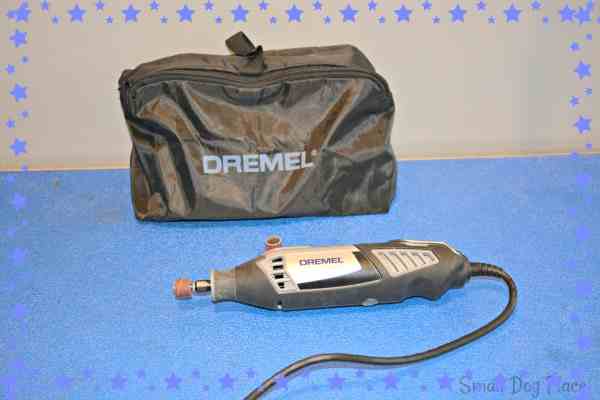- Small Dog Place Home
- Grooming
- Dremeling Your Dog's Nails
Dremeling Your Dogs Nails: 10 Steps to Making You a Dremel ® Pro
Dremeling Your Dogs Nails
Pets make our lives full, but they also need care just like a human baby. They can’t keep themselves as clean and healthy as we do. We must give our attention, support, and effort in return for their unconditional love.
These efforts include some small things like providing a proper diet, happiness, health, and overall hygiene. Cutting the nails is one of those significant ‘responsibilities’ of dog owners to keep their fur babies clean, in shape, and healthy.
You probably know the traditional method to cut dog nails using nail clippers. Many dog owners still use them.
But, nowadays ‘Dremeling’ is becoming a fantastic alternative to clipping the nails of our beloved furry friends. Reason being is that the clippers may cause pinching or nail breakage.
It may also cut deep into the quick of the dog’s nail. The quick is just another word for blood supply or vein that runs part way down a dog’s nail.
Dremel® is safe. It works best on the dogs with clipper anxiety. If your dog has thick nails, then the Dremel® can achieve a smooth, rounded nail edge without hurting him. Dremeling is a great way to maintain healthy nails.
What is a Dremel®?
In the rare event that you have not heard of a tool, a quick explanation is necessary. Developed by Albert J. Dremel, an American in 1932, these rotary tools can perform a variety of tasks from cutting, polishing, sanding to carving a pumpkin and filing dog nails.
Variable speed units can cover a wide range of RPM, but for use as a dog nail grinder, a slower speed is sufficient.
Dremeling Your Dogs Nails: Step By Step Tutorial
Nail maintenance of a pet is quite frustrating, especially when you are a new owner. We become nervous because even our dogs are generally afraid of such tools.
A small mistake can end up hurting them the most. So, it is essential to know how to dremel dog nails! Let’s find out some easy techniques. Either keep scrolling or click on individual links below to be taken to the appropriate section.
- Introduce the Dremel and Its Sound
- Make Your Dog Calm
- Allow Your Dog to Sniff the Dremel
- Find a Comfy Spot Before Dremeling Your Dogs Nails
- Holding Paws When Dremeling Your Dogs Nails
- Using the Tool For Dremeling Your Dogs Nails
- Go Slow With Puppies
- Perfect Nail Trimming
- Positioning to Make Dremeling Your Dogs Nails Easy
- Take Care of The Quick
1. Introduce the Dremel® and Its Sound
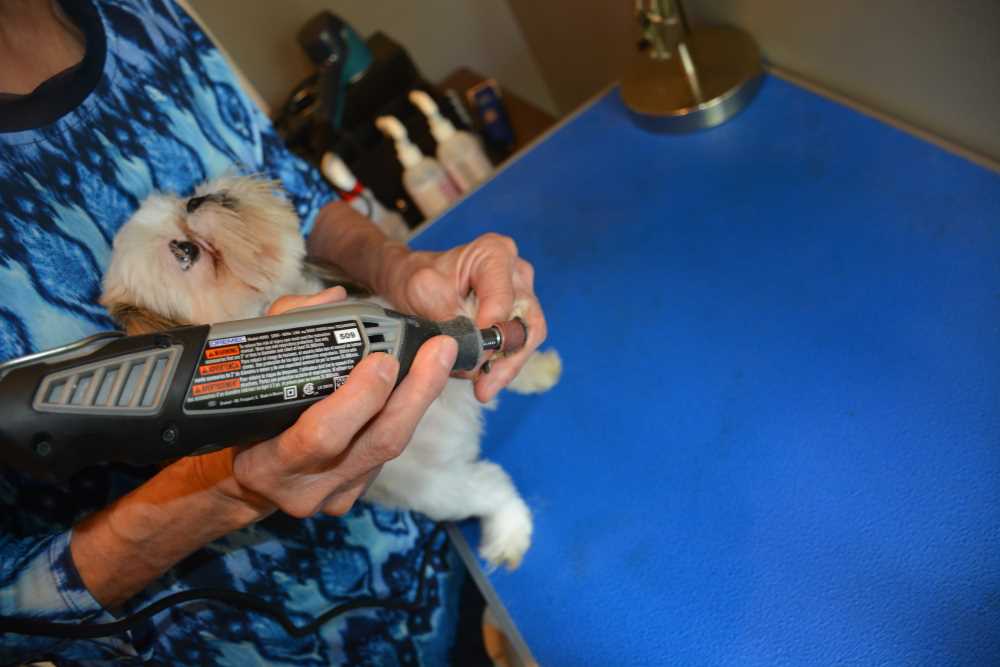 Introduce the Dremel Tool and Its sound and vibrations first, before attempting to file the nail.
Introduce the Dremel Tool and Its sound and vibrations first, before attempting to file the nail.When the dog is small or just a couple months old, start training him about the whole process. Introduce him with the sound of Dremel. It’s okay if you don’t want to trim his nails if you feel that he is too little for the process but it is essential to make him realize that this process is positive and it is going to happen soon.
For small breed puppies, it will be awhile before a Dremel® tool can be used on his tiny nails. You can train your young puppy to tolerate having his paws held, his feet touched, and the sound of the Dremel® motor.
2. Make Your Dog Calm
 Make sure your dog is calm. Give a calming aid in the form of a treat if your dog is acting nervous or stressed.
Make sure your dog is calm. Give a calming aid in the form of a treat if your dog is acting nervous or stressed.Most dogs don’t like the process of dremeling. They may feel afraid of the sound or hate their nails to be trimmed. Whatever the reason may be, If they are not comfortable enough, they start moving and don’t allow you to touch their paws.
So, it is essential to make them feel comfortable by continuously taping or massaging them. Calm them down with your soothing words and a treat or two to give them confidence that you are not going to hurt them in any case.
Calming treats are very useful for nervous dogs. You can also try a trick. When the dremel is on, feed the dog with the treats. And, when the dremel is off, don’t feed him at all. Using this method, he will realize that when the machine is on, he is getting the treats.
Here are a few suggestions for calming treats that have received high ratings.
- Natural Calming Product
- Duck flavored
- Made with mild organic chamomile
- Useful in all types of stressful situation including dremeling
- Comes with a money back guarantee
- Tastes like a treat
- Turkey flavored chewable
- Includes Suntheaine, a pure form of L-Theanine that helps stimulate brain waves to promote relaxation without the drowsy feeling
- Wheat free treats also contain organic ginger root, L'Tryptophan, Thiamine and Organic Chamomile and Organic Passion Flower to help balance dog behavior
- Also contains Valerian Root, Organic Hemp Powder and Organic Hemp Oil
- Contains Organic Hemp, organic chamomile, passion flower used by native Americans to naturally ease nerves.
- Also contains fruits and vitamins including apples that provide antioxidants, vitamin A and C, Carrots add fiber and a significant source of Vitamin A and Potassium, and Baobab which offers the highest antioxidant of any fruit in the world
- Human Grade
- Tasty to dogs
3. Allow Your Dog to Sniff the Dremel
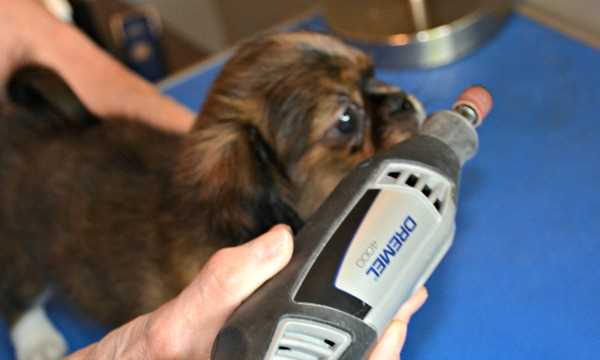 Allow the dog to sniff the Dremel tool. All dogs rely on smell to check out objects in their environment.
Allow the dog to sniff the Dremel tool. All dogs rely on smell to check out objects in their environment.Dogs learn much about their environment through smell, so most dogs are going to want to sniff the tool. You can allow this as long as the motor is not running. Show the Dremel® and let your dog sniff both the handle which will have your scent as well as the end that will be doing the filing.
You can also then turn on the machine and treat. Do not allow the dog to sniff the end of the sanding drum when the motor is running, or you run the risk of injuring his nose.
4. Find a Comfy Spot Before Dremeling Your Dogs Nails
It is necessary to keep dogs calm, comfortable, and happy, to accomplish the dremeling process. So, provide a place where he can comfortably sit or lie down. This could be on the floor, on a grooming table or on your lap.
Since nails are all part of the grooming process, it is helpful to Dremel in the same place as you would accomplish your other grooming tasks. Touch his feet and paws.
Getting the dogs comfortable with the touch of his feet is a step one should never avoid. Young dogs may struggle sometimes and don’t sit still during the process. So, create an atmosphere that they enjoy dremeling and will voluntarily stay with you. You will always be more successful if you go slowly, first touching and massaging and work you way up to the actual dremeling.
5. Holding Paws When Dremeling Your Dogs Nails
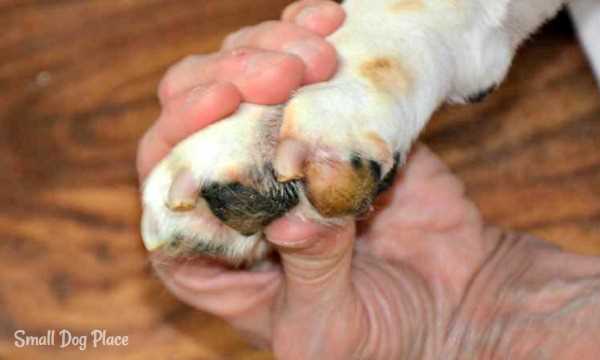 The best way to hold the paw is between the fingers, thumb on the paw pads and the four other fingers above.
The best way to hold the paw is between the fingers, thumb on the paw pads and the four other fingers above.As you know or may have experienced many dogs, try to pull their paws away during the session, which may hurt them or the person who is dremeling. It is essential to know the correct holding method to prevent accidents.
While grinding, place your thumb on the bottom and other four fingers on the top. Hold the paw firmly but gently so that you don’t hurt the dog unknowingly. Don’t be rigid but stop allowing him to pull his leg everytime he wants, otherwise he may make it a habit.
6. Using the Tool For Dremeling Your Dogs Nails
Trimming nails by using the dremel is not difficult. If dogs are adequately introduced to the dremel, then it is also not scary. Although, some puppies may startle initially and take some time to get used to the dremeling process.
While using, we should keep in mind that we should not hold the dremel for the more extended period. Also, start with the minimum speed to avoid heavy noise at first. Just touch the dremel on the nail top for 3 to 5 seconds only. Then, jump nail to nail and make it a pattern. If the dog is tolerating the noise and vibrations, you can increase the speed slightly.
Dremeling Your Dogs Nails Warnings and Precautions
The Dremel® can make the nails hot because of its high rotational speed. Always check the nails to be sure they are not too hot otherwise the skin of dogs may hurt a bit.
For long breed dogs, you will either want to trim the hair around the paw, or pull the hair back and away from the sanding drum. Hair can quickly become tangled into the tool.
7. Go Slow With Puppies
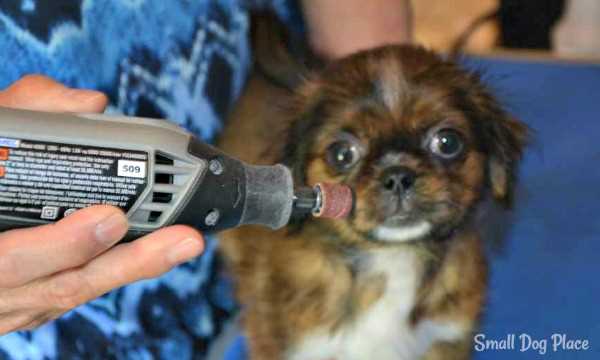 Take it slow and easy with puppies and ease into the dremeling process.
Take it slow and easy with puppies and ease into the dremeling process.If you have a new dog or a small puppy, don’t rush. Dremel one nail a day. Let them get used to the machine as well as its sound. Such dogs may take many small sessions rather than having one full course. During the process, try to keep them happy and motivated by feeding them their favorite treats and talking continuously.
Utilise this time as your bonding time with them. You will be most successful if you demonstrate a confident, gentle, but firm attitude. Dogs do tend to sense fear if they suspect you are a nervous handler. It’s all a matter of trust.
8. Perfect Nail Trimming
Once you get the required length, start rounding the edges. Do not forget this step as it helps to avoid scratches from the sharp edges. Also, check the nails from inside as some edgy nails also require underside trimmed chips. The finished nail will be short, rounded, and smooth.
When training the dog for dremel use, keep him calm and confident so that he cooperates. They may not like the process at all, but it is essential to let them know that this is compulsory but not hurtful.
9. Positioning to Make Dremeling Your Dogs Nails Easy
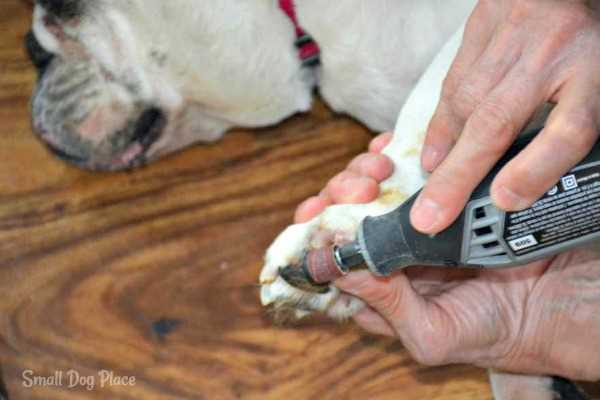 When dremeling a large breed, encourage them to lay on their side. This makes the process much easier.
When dremeling a large breed, encourage them to lay on their side. This makes the process much easier.If you have a small pooch, then you can easily dremel his nails by keeping him in your lap. But what about the larger breeds? Professionals suggest that if we have a medium dog, then we should place the dog belly up on our lap. And, a large dog can be laid gently on his side on the floor in front of the person who is going to dremel the nails.
If our dog is longer than us, then we should spin him around to cut the back nails. This way, we can easily dremel the nails without causing any discomfort to our furry friend. Once the dog gets used to this process, we can also try to have them up on a grooming table. But, do not hurry.
10. Take Care of The Quick
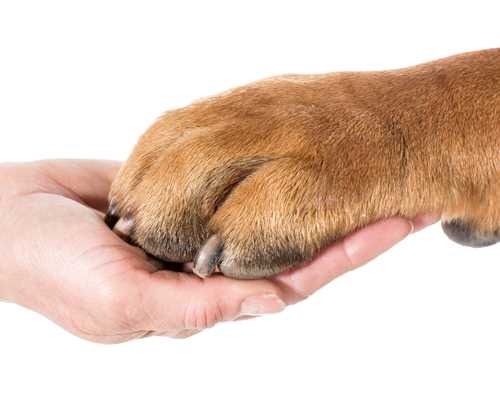 The quick is the blood vessel that runs down each nail. Don't cut into it or dremel too close as you will hit the quick and the nail will bleed.
The quick is the blood vessel that runs down each nail. Don't cut into it or dremel too close as you will hit the quick and the nail will bleed.While dremeling, it is crucial to take extensive care of the dog’s quick. Dog’s nail contains both a blood vessel and a nerve. Just like clipping, if we Dremel to close and hit the quick, the nail is going to bleed, and the dog will feel pain.
Dremeling is best accomplished by sanding a little at a time until you see a small white circular spot in the center of the nail. Once you reach this small white spot, stop dremeling. If the dog does not stay still, put the Dremel® away and hold him tight until he relaxes. But, don’t let him go.
Here are a few Dremel® tools under $30 that work well on dog nails:
Dremeling Your Dog's Nails: Wrapping it Up
These are the steps to remember when using the dremel to trim dog’s nails. Dremeling can be a great substitute or as an addition to using a nail trimmer.
As with any other grooming task, the primary thing to remember is to use a positive approach. Provide taste treats, find the best location, and continue to reassure him with a calm voice. But, just in case…
Keep some styptic powder with you. If you happen to cut into the quick accidently, the powder will aid in clotting. Some professionals also suggest trying corn-starch, which can serve the same purpose.
If you are an asthmatic patient, wear a respirator or dust mask. Also, wear safety glasses to keep the nail dust out of your eyes.
So, that’s all for how to dremel dog nails! I hope this article will help you in making the whole dremeling process easy, quick, and convenient. Stay tuned for more updates on pet’s care. Thank you for your patience and have a happy bond between you and your pets.
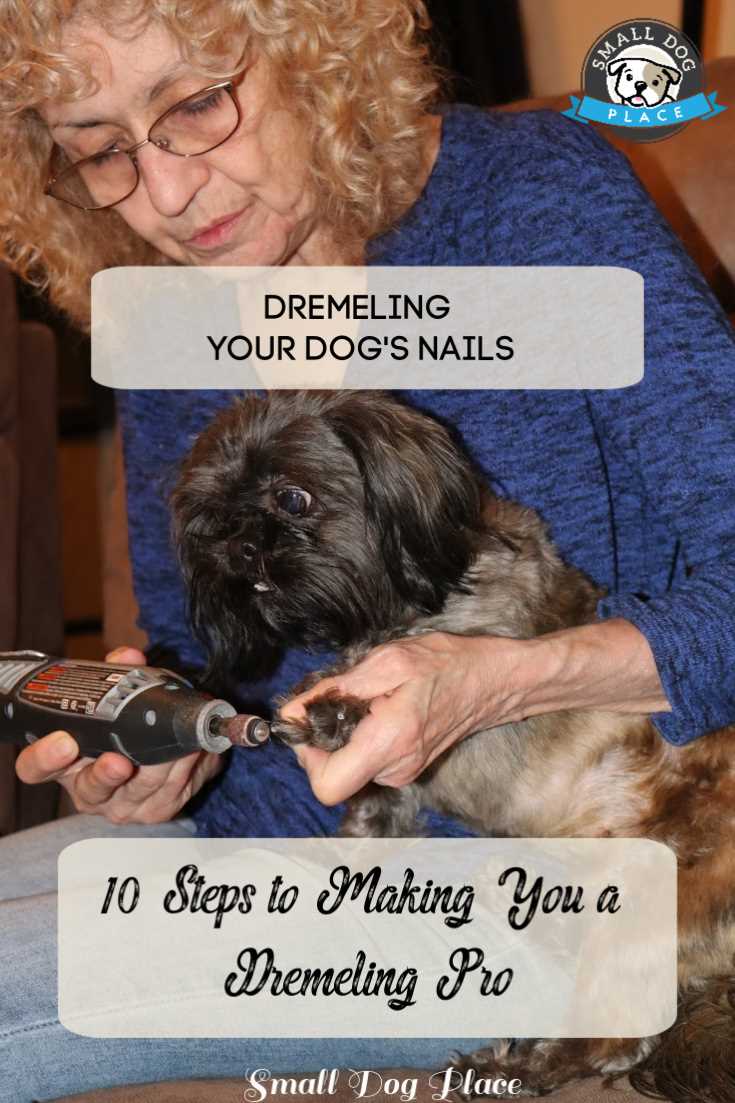 Dremeling Dog Nails Pin
Dremeling Dog Nails PinRELATED ARTICLES
About Janice (author and voice behind this site)
Having lived with dogs and cats most of her life, Janice served as a veterinary technician for ten years in Maryland and twelve years as a Shih Tzu dog breeder in Ohio.
Her education includes undergraduate degrees in Psychology with a minor in biology, Early Childhood Education, and Nursing, and a master's in Mental Health Counseling.
She is a lifelong learner, a dog lover, and passionate about the welfare of animals. Her favorite breed for over 50 years has been the Shih Tzu, but she has also lived with Poodles, Maltese, Yorkshire Terriers, Beagles, English Bulldogs, Carin Terriers, and a Cocker Spaniel.
When not writing, reading, and researching dog-related topics, she likes to spend time with her eight Shih Tzu dogs, husband, and family, as well as knitting and crocheting. She is also the voice behind Miracle Shih Tzu and Smart-Knit-Crocheting
Does This Article Deserve Your Thumbs Up?
We always appreciate your support and encouragement. Your thumbs up means so much to us. Please like this article.
If you find this page or any page on Small Dog Place Helpful, or useful in anyway, I'd love it if you would click the small heart found on the bottom right of each page.
You can also share or bookmark this page -- just click on the:

Free Monthly Newsletter
Sign Up for Our Free Newsletter and get our Free Gift to You.
my E-book, The Top 10 Mistakes People Make When Choosing a Dog (and how to avoid them)
